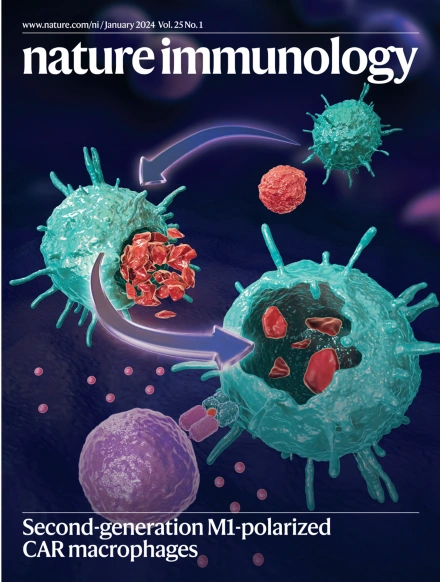Recruiting lymphocytes
IF 27.7
1区 医学
Q1 IMMUNOLOGY
引用次数: 0
招聘淋巴细胞
循环淋巴细胞通过趋化因子CCL19和CCL21从血液中招募到稳态淋巴结(LNs), CCL19和CCL21是CCR7受体的配体。然而,在感染和炎症时,反应性LNs发生结构变化并改变其基因表达以促进淋巴细胞活化。在Cell中,Chen等人研究了炎症如何改变初始淋巴细胞LN募集的趋化信号。他们发现,在反应性LNs中,小鼠高内皮小静脉(HEVs)和成纤维网状细胞(FRCs)对CCL21的依赖性降低。相比之下,Ch25h在hev和迁移的朗格汉斯细胞中高度表达。Ch25h与FRCs表达的Cyp7b1一起控制初始淋巴细胞上表达的趋化受体EBI2的羟甾醇配体的合成。作者发现,幼稚B细胞更依赖于这种羟甾醇- ebi2轴,以募集到炎症的LNs中,以及在几种肿瘤模型中。CCR7+初始T细胞和中枢记忆T细胞变得更加依赖ccl19介导的对炎症LNs的募集。改变这些趋化介质表达的信号尚不清楚,因为作者排除了干扰素信号;然而,他们指出慢性下调CCL21可能会改变适应性免疫细胞反应。原始参考:Cell https://doi.org/10.1016/j.cell.2024.11.031 (2024)
本文章由计算机程序翻译,如有差异,请以英文原文为准。
求助全文
约1分钟内获得全文
求助全文
来源期刊

Nature Immunology
医学-免疫学
CiteScore
40.00
自引率
2.30%
发文量
248
审稿时长
4-8 weeks
期刊介绍:
Nature Immunology is a monthly journal that publishes the highest quality research in all areas of immunology. The editorial decisions are made by a team of full-time professional editors. The journal prioritizes work that provides translational and/or fundamental insight into the workings of the immune system. It covers a wide range of topics including innate immunity and inflammation, development, immune receptors, signaling and apoptosis, antigen presentation, gene regulation and recombination, cellular and systemic immunity, vaccines, immune tolerance, autoimmunity, tumor immunology, and microbial immunopathology. In addition to publishing significant original research, Nature Immunology also includes comments, News and Views, research highlights, matters arising from readers, and reviews of the literature. The journal serves as a major conduit of top-quality information for the immunology community.
 求助内容:
求助内容: 应助结果提醒方式:
应助结果提醒方式:


